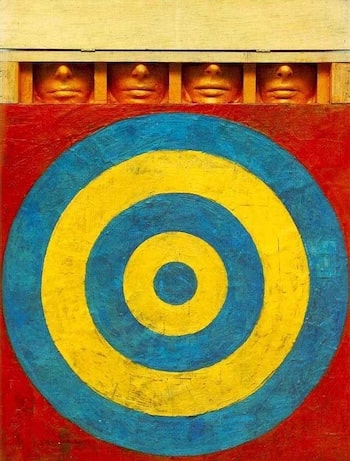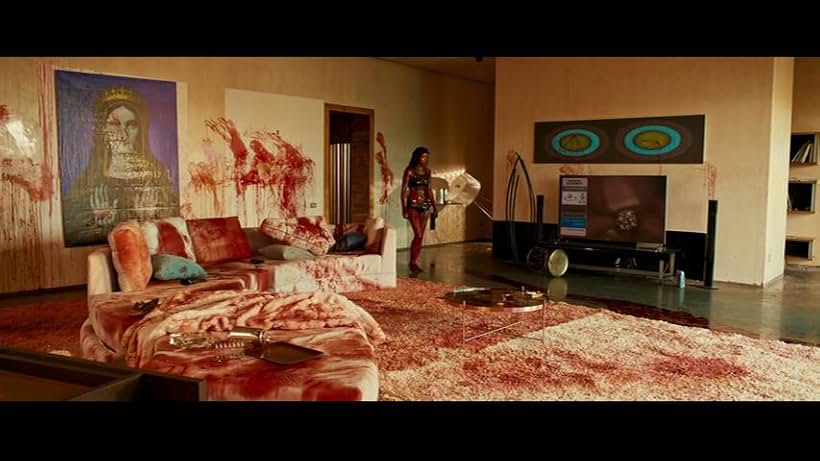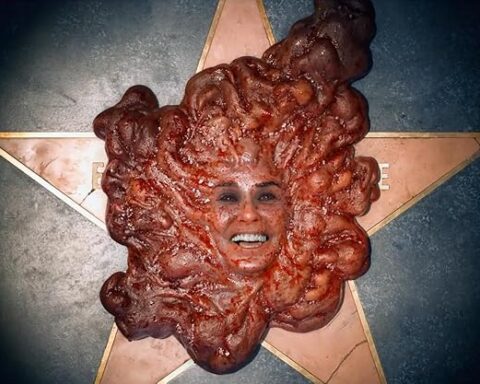Jasper Johns’ Target with Four Faces and Coralie Fargeat’s Revenge establish a profound connection through themes of subject-object relationships, power dynamics, violence, and justice. Both works transform the audience into active participants and invite ethical questioning. While Revenge explores the boundaries of violence and revenge, Johns’ work addresses these themes on a more abstract level.
Target with Four Faces turns the viewer into both a visual and intellectual target. The target figure draws the viewer’s gaze to its center, while the four faces above, with their anonymity and lack of direct gaze, create a sense of tension. The fact that these faces do not “watch” us reverses the conventional roles of art and its audience.
Revenge contrasts Jen’s gaze with those of the male characters. At the beginning of the film, Jen is positioned as the sexualized object of the male gaze. However, during her revenge journey, she inverts this dynamic, and the men become her targets. The film explores Jen’s transformation into a subject and the relationship between the gaze and violence. Johns’ target imagery can be likened to Jen’s symbolic transformation in her pursuit of justice.
In Johns’ work, the faces are anonymous, and their incomplete visibility evokes a deliberate sense of “silencing.” These faces are stripped of individuality, becoming symbolic entities.
In the film, the male characters (Richard, Stan, and Dimitri) initially appear as powerful individuals. However, as Jen’s revenge progresses, their cowardice and weaknesses are exposed. They, too, become dehumanized figures reduced to targets in Jen’s gaze. In this context, Johns’ anonymous faces can be interpreted as a metaphor for how Jen perceives her prey as stripped of their humanity.
Johns’ Target with Four Faces uses the visual symbol of a target, which implicitly suggests violence. The target simultaneously invites physical aggression and challenges the viewer to consider ethical and artistic questions. This passive-aggressive tension is what gives the work its power.
The violence in Revenge, while physical and graphic, prompts the audience to engage in an ethical examination of Jen’s struggle: Can justice be achieved through such extreme violence? Much like Johns’ work, the visual depiction of violence creates a conflict for the viewer, who must question both the morality of the acts and their aesthetic presentation.
Johns’ Target with Four Faces addresses the theme of objectification. The faces are silenced, anonymous, and rendered passive. Yet this passivity reverses itself by demanding the active engagement of the viewer.
In Revenge, Jen is initially positioned as a passive “object,” the target of the male gaze and control. However, through her journey of revenge, the balance of power shifts entirely. The men now become the targets of her retribution. Jen’s emergence as a subject can be seen as a rebellion against the passivity of the faces in Johns’ work.
The colors in Johns’ work (red, blue, yellow, and black) create a simple yet striking visual impact. The red at the center of the target, in particular, evokes associations with violence and danger.
The visual aesthetic of the film similarly relies on the potent use of color. The bright red of blood becomes a symbol of Jen’s journey of vengeance. The yellow tones of the desert and the vivid red of blood recall the colors and meaning of Johns’ target imagery.
Nil Birinci


